Help Desk SLA: Measuring and Optimizing Service Levels
The help desk SLA helps companies ultimately enhance customer satisfaction and optimize support operations. Check how an SLA works to maintain a high standard of customer service.
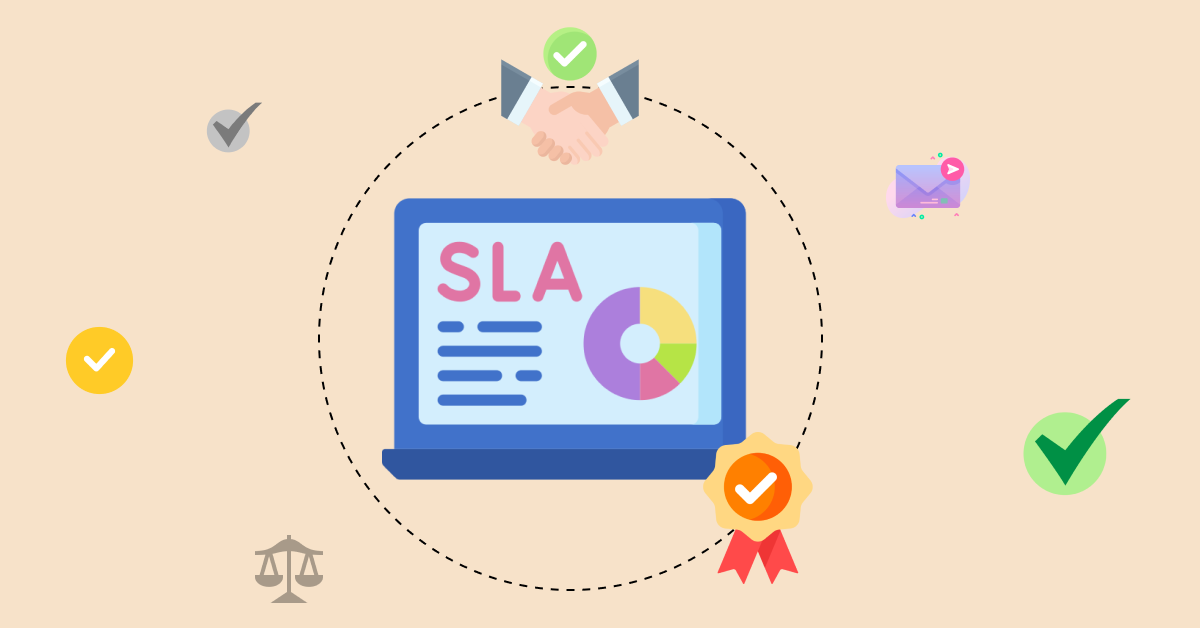
The help desk SLA helps companies ultimately enhance customer satisfaction and optimize support operations. Check how an SLA works to maintain a high standard of customer service.

The Help Desk SLA, also known as the Service Level Agreement, holds great significance for present-day businesses. It plays a vital role in guaranteeing that customers receive prompt and satisfactory service.
The significance of help desk service level agreements can be understood by the fact that 77% of the service desks sign up for SLAs. The agreement sets clear expectations and requirements for customer support while also providing guidelines for assessing performance.
Setting clear standards and goals allows businesses to better handle customer inquiries while creating a more efficient workflow process. Now that you are intrigued, let us dive into the ultimate guide on service desk SLA.
A help desk service level agreement (SLA) can be defined as a special agreement between a help desk service provider and a customer. It outlines the expected service level and the outcomes if those expectations are not met. SLAs are significant for both service providers and customers because they provide clarity on each party’s roles in delivering excellent customer service.
An SLA typically outlines the scope of services to be provided by the help desk service provider, the procedures for support requests, the expected resolution time and the metrics for measuring performance. The SLA also includes the consequences if the service provider fails to meet the defined service level management, such as financial compensation or termination of the contract.
Key objectives:
Below are the key benefits of strong SLA management and how it can transform your service desk into a powerhouse of performance.
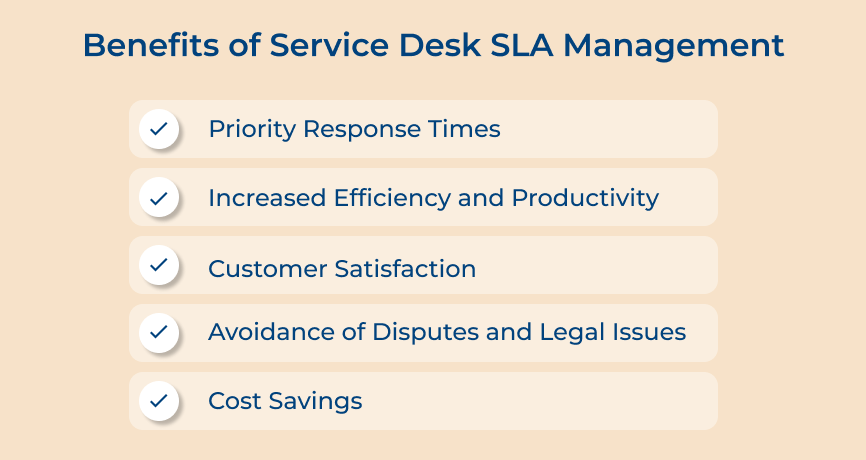
1. Priority Response Times
Help desk SLAs provide a guarantee of priority response times. It means that your support team will be able to prioritize and resolve customer issues quickly. With an SLA agreement, customers feel confident that their needs are being fulfilled. The level of reliability can help build trust and improve your overall brand reputation.
2. Increased Efficiency and Productivity
The service desk SLA ensures your support team will have clear guidelines for issue resolution and response times. It translates to increased efficiency and productivity. Following established processes and procedures enables your team to minimize downtime and prioritize higher-priority customer issues.
3. Customer Satisfaction
All businesses strive to keep customers and make money. With an effective service desk SLA, you can improve customer satisfaction rates. It is because the SLA helps guarantee that your customers receive a quick and effective resolution to their problems. When customers’ needs are fulfilled by a company, they will become loyal to it and recommend its services to others.
4. Avoidance of Disputes and Legal Issues
Disputes can arise between businesses and customers. Such disputes can even lead to legal action. Clearly outlining the terms of your help desk service enables you to avoid conflicts and misunderstandings with customers. An SLA agreement can help protect your business by providing proof of service levels and response times should legal disputes arise.
5. Cost Savings
Effective help desk support SLAs can help reduce the cost of support services. When issue resolution times are clearly defined and priority issues are addressed promptly, the overall cost to support such issues is reduced. It can save expenses for your business. The saved expense can then be directed toward other areas of the business such as product development or increasing customer support channels.
Here are some of the different types of SLAs that help desk teams use to measure their performance and ensure they are meeting customer needs.
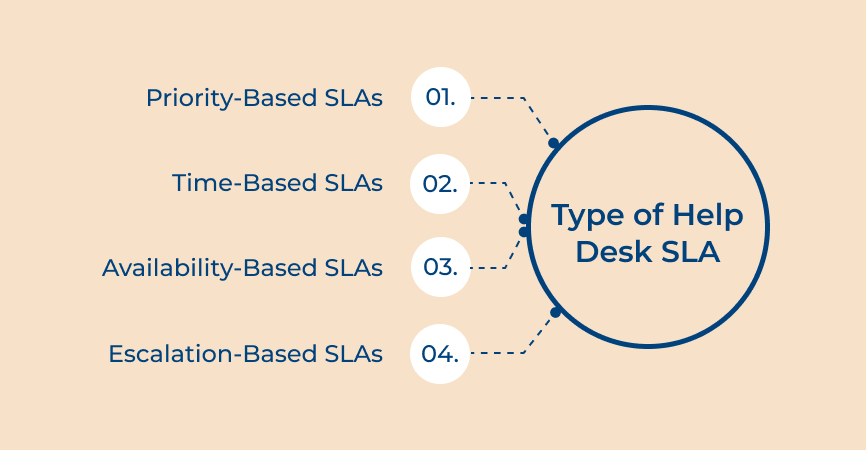
SLAs are created to offer different levels of assistance depending on how serious the problem is. A highly critical issue might require a response within 15 minutes, whereas a less urgent issue could have a response time of 4 hours. Priority-based SLAs enable help desk teams to prioritize their workload based on the criticality of each issue, ensuring that they are addressing high-priority issues first.
SLAs that rely on time are utilized to gauge how long it takes to handle a problem after it is reported. They can include both response time and resolution time metrics. A response time SLA might stipulate that the help desk team needs to reply to an issue within 2 hours, but a resolution time SLA might require them to fix the problem within 24 hours.
Availability-based SLAs focus on how often the help desk is actually up and running. They matter most when support needs to be around the clock. Let’s say an SLA promises 99.9% uptime; it’s saying the help desk should rarely be down. So the customers can reach out whenever they need help, without second-guessing if support will be there.
Escalation-based SLAs define the process for escalating issues that cannot be resolved in a timely manner. Such a type of SLA is important because it ensures that issues that require additional attention are addressed quickly. An escalation-based SLA may require that issues that are not resolved within a defined period will be automatically escalated to a more senior support team.
The following are the best practices you should consider when developing or refining your help desk SLAs, enabling you to enhance service delivery and build stronger customer relationships.
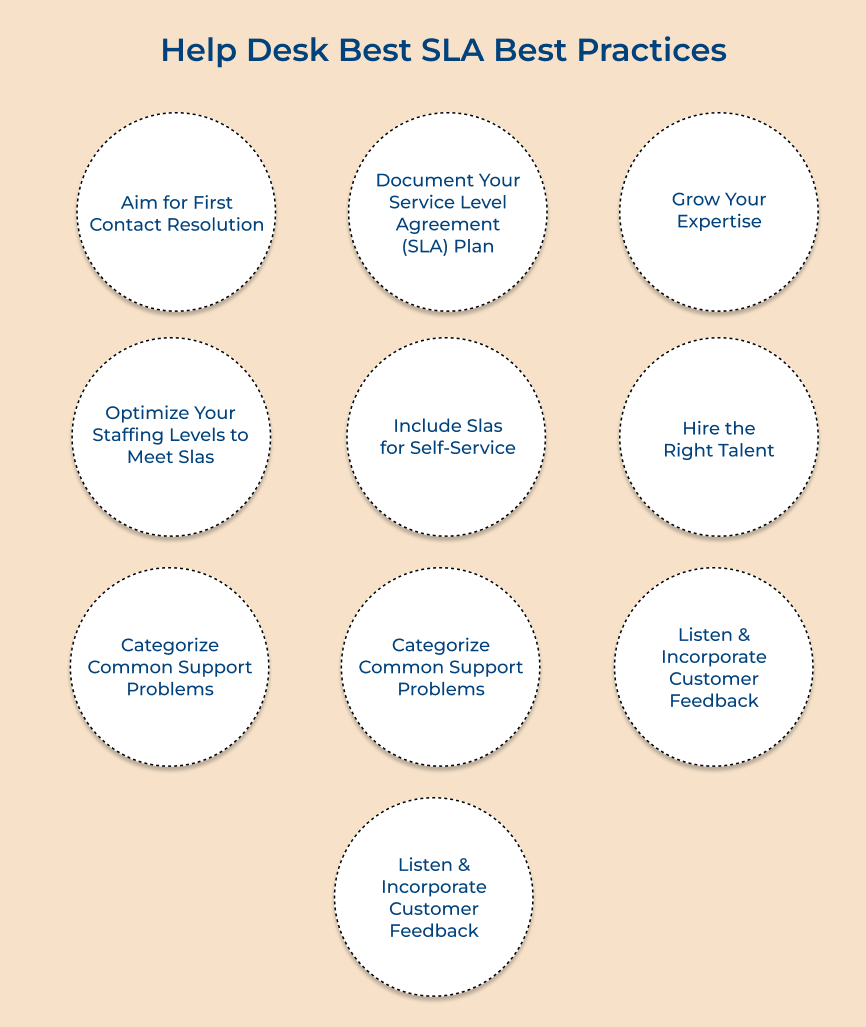
Documenting a service level agreement (SLA) plan is essential for establishing best practices in the help desk environment. An SLA plan outlines expectations, provides guidance on setting goals and helps to ensure customer requirements are met.
The key elements that should be included in any SLA plan include clear definitions of responsibilities, standard processes for responding to requests and metric tracking measures. The metrics can be response times, resolution rates, and communication protocols of the support staff.
Growing knowledge and expertise are important parts of creating a successful help desk SLA template. Having a comprehensive understanding of the different types of SLAs, their benefits, and best practices is essential to enhancing customer satisfaction. Without strong expertise on the subject matter, it can be difficult for businesses to make informed decisions when developing SLAs.
If you’re using help desk SLAs, don’t just set them and forget them. Take the time to understand the different types, how they actually work and what makes them effective. The more you know, the easier it is to set realistic expectations and hold your support team to a standard that actually means something.
When it comes to implementing best practices for help desk SLA software, the right talent is essential. Every organization should strive to hire people with a passion and commitment to customer service excellence, as well as technical problem-solving skills.
If your team consists of motivated individuals who are dedicated to providing superior customer service and have expertise in handling difficult issues effectively, you will benefit from improved efficiency. Having such top-notch help desk staff means that you don’t need additional resources or investments in training new employees.
An effective SLA (service-level agreement) is essential to the success of any help desk. Customer feedback should be taken seriously and incorporated into their support SLAs. It requires a strong commitment from both parties to create an environment that facilitates collaboration and mutual benefit.
Listening to customers ensures that they feel heard and valued, while incorporating their suggestions into your support SLAs provides them with additional assurance that their needs will be met. Service providers must prioritize obtaining customer feedback, as well as responding quickly when needed.
New studies indicate that there is a growing trend towards self-help customer support, surpassing traditional approaches like phone or email. Businesses should incorporate Service Level Agreements (SLAs) specifically for self-help options.

SLA’s enable customers to obtain solutions effortlessly even outside business hours. Make sure your service offerings are easy to understand with clear instructions that can be followed by anyone, regardless of technical skill level. All relevant information about services must be readily available so customers don’t have to search around for answers.
The implementation of SLAs for self-service is essential to ensure customer satisfaction, but categorizing common support problems can be a powerful tool as well. Categorization helps to organize incoming requests in order to properly prioritize them and provide customers with the most efficient resolution possible.
Implementing an organized system of categorization makes it easier to assign staff members according to their areas of expertise. It also streamlines communication between help desk agents, supervisors, and other stakeholders who may need access to tickets or reports related to specific support topics.
Achieving the best SLAs for a help desk requires more than just categorizing common support problems; it also necessitates optimizing staffing levels. Companies must carefully assess their current staff needs, as well as evaluate potential future scenarios so that resource allocations can be adjusted accordingly.
Businesses must ensure that staff members have adequate knowledge of both customer service processes and technical product issues. Developing comprehensive procedures for handling various types of inquiries will make your teams better equipped to respond quickly and accurately to any situation.
The goal of effective customer service is to deliver the best possible experience. Businesses should aim for first contact resolution (FCR). Symbolically, FCR can be thought of as a bridge between customers’ expectations and their ultimate satisfaction with a business’s services or products.
The approach allows businesses to respond quickly and accurately to customer issues. It also reduces costs associated with repeat contacts and improves overall customer satisfaction ratings by ensuring that inquiries are handled in an efficient manner. When customers feel they are being dealt with promptly and appropriately, they are more likely to be loyal customers going forward.
Tracking the performance of a help desk is an essential part of ensuring optimal service level agreements (SLAs) are being met. Performance metrics should be measured regularly to ensure that SLA goals are achieved and customer satisfaction remains high.

Measuring the key indicators will provide insight into how your team can better serve its customers. Analyzing the data gives you actionable information that can lead to meaningful improvements such as creating more efficient workflows or providing additional training to agents.
Workflow automation is one of the best practices that should be implemented for service desk SLA software. Taking action can help alleviate various typical problems, like delays in service and exceeding the budget. Automating tasks enables employees to concentrate on more intricate assignments. 45% of corporate teams are involved in the same workflow automation process.
Automated workflows offer visibility into operations through detailed monitoring options, which allow staff to quickly identify pain points and take corrective action when needed. It makes it easier to manage resources and ensure compliance with organizational policies.
Here are the real-world examples that show how different businesses define, measure and deliver on their support commitments.
Setting response time targets such as how long it takes for an agent to respond to a user query or request. It will ensure customers get their queries answered promptly and consistently, regardless of who they speak with on the help desk team.
Establishing resolution time targets, which refer to how quickly issues are solved or resolved within a given period. It helps the organization maintain a high standard of service delivery while meeting customer expectations.
Include metrics tracking performance over time so they can continually monitor progress and make improvements where necessary. Without the metrics, it is impossible to understand if the company is on the desired path and how much they have progressed so far.
Having well-defined SLAs enables organizations to properly manage resources, optimize processes, meet customer demands and generally provide higher levels of service quality even outside business hours. Following these best practices enables businesses to create effective and reliable help desks that positively contribute toward overall success.
Check out the critical SLA metrics you should monitor and how they can help you achieve operational excellence while keeping your customers engaged.
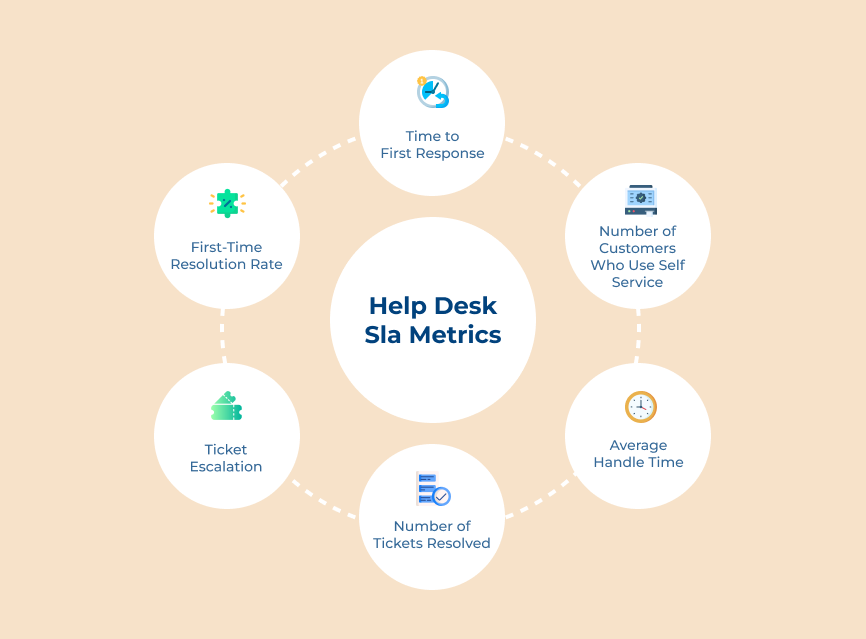
Time to First Response is a metric used in the Service Level Agreement (SLA) of the help desk. It measures how long it takes for an agent to provide a customer with a response after they have requested support. The metric is important as it helps assess if the customers are receiving satisfactory service from their providers and can also be used to measure the performance of agents within a helpdesk system.
When creating SLAs, companies should take into account different types of requests such as emails, phone calls and web forms, when setting time-to-first-response goals. Businesses should also consider factors like time zones and language barriers when deciding on realistic targets for this particular metric.
In terms of customer service, the age-old saying “the effort you invest yields greater rewards” remains accurate. Self-assistance offers companies a cost-effective method to address customer issues conveniently, bypassing the need for staff involvement.
When customers find solutions easily through self-service options, they become empowered and less reliant on your help desk team. Tracking the number of customers who make use of these services allows you to measure if your efforts to improve user experience are working or not.
Average Handle Time (AHT) isn’t about rushing through calls; it’s about cutting the waste. Think of it like streamlining a process: the fewer the bottlenecks, the smoother the experience. When AHT is under control, teams work more efficiently, customers get quicker help and support feels more competent.
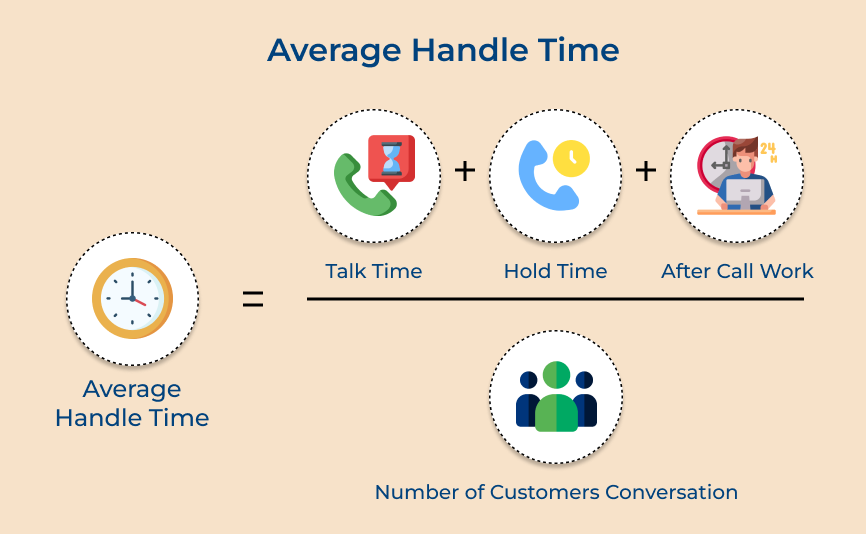
There are two main types of AHT: task-based and session-based. Both are used as metrics to measure how quickly help desk staff can complete tasks or transactions. Task-Based AHT looks at individual steps within a process. The session-based AHT measures the average time taken for each support request from start to finish. When done correctly, these strategies achieve greater accuracy and speed up resolution times significantly.
Measuring the number of tickets resolved can be an effective way to evaluate help desk performance. The metric provides insight into how well a team is managing customer inquiries and requests, as well as its ability to resolve issues in a timely manner. It helps managers identify any areas that need further improvement or resources allocated.
Tracking the number of tickets resolved can also provide valuable information on which topics customers are having difficulty with the most often. Having such knowledge may help organizations better understand their customer base’s needs and create strategies for providing more efficient solutions.
The theory of ticket escalation has been studied extensively, as it is an important part of a successful help desk service level agreement (SLA). The concept involves escalating unresolved tickets to higher levels in order to ensure that they are addressed more quickly and efficiently.
One benefit of escalations is that they can be used to prioritize certain types of tickets over others. Tickets relating to system outages or other urgent issues may need to be escalated so that they are handled immediately. Using ticket escalations allows for improved customer satisfaction by ensuring that their requests are addressed promptly.
First Time Resolution Rate (FTRR) is a key performance indicator for measuring the efficiency of help desk operations. It’s an important element in Service Level Agreements (SLAs) since it measures how quickly customer inquiries can be answered and resolved without needing to escalate or re-contact the customer later. The average FCR industry standard is about 70%.
A high rate of FTRR indicates that the technical team is able to provide timely, accurate solutions while still providing excellent service quality. The best practice when assessing your help desk’s FTRR is to set realistic goals based on industry standards, as well as user feedback from surveys and other forms of communication.
Help desk SLA solutions are a critical component of any business’s customer service system. A well-defined service desk SLA can improve the quality of customer support, reduce wait times and increase overall satisfaction with products or services.
Investing in a good service desk SLA solution is essential for providing excellent customer service and improving customer satisfaction levels. With careful consideration of features and functionality combined with diligent tracking of results against expectations, businesses can make sure their help desks meet all their needs while providing top-notch support at every step.
Companies can accurately measure Help desk SLA performance through various key indicators that can be considered. It includes response time-how quickly customers receive assistance and resolution rate success with which issues are resolved. The first contact resolution shows if the problems are being solved on the initial call or require further action. The customer abandonment rate implies that when people give up due to long wait times.
The average wait time is a critical factor when measuring the performance of any support team. The average wait time for a service desk service level agreement (SLA) refers to the average amount of time a customer or user has to wait before their request /inquiry is addressed by the service desk team. In the context of SLAs, it measures the responsiveness and efficiency of the support.
The cost of a help desk SLA (Service Level Agreement) can vary significantly depending on the specific needs and requirements of the business. Factors generally are the level of support one needs, the number of users or customers being served and the service provider being chosen. Some help desk SLA software may offer tiered pricing plans based on the number of support agents or volume of tickets.
Selecting the best help desk SLA software depends on your specific business requirements and priorities. Several reputable options are available in the market, each offering unique features and capabilities. Consider factors such as ease of use, customization options, integration with existing systems and scalability. Veemo.io and Omni24 are great options for companies looking for the best help desk SLA software.
Make sure to start by defining clear plus measurable objectives that are specific, achievable, and time-bound. The objectives should encompass response and resolution times for different ticket priorities. It will set the foundation for well-defined customer expectations. Collaboration and alignment among all stakeholders are essential to establishing an SLA that caters to the needs of both the business and its clients.

Market better, sell faster and support smarter with Veemo’s Conversation Customer Engagement suite of products.
Unify all your customer data in one platform to deliver contextual responses. Get a 360 degree view of the customer lifecycle without switching tools.
Connect with the tools you love to reduce manual activities and sync your business workflows for a seamless experience.
 https://veemo.io/wp-content/uploads/2024/12/customer-service-response-time.png
1256
2400
Webvision Solution
https://veemo.io/wp-content/uploads/2024/11/veemo.svg
Webvision Solution2025-10-17 10:51:142025-10-17 10:51:149 Effective Tips to Reduce Customer Service Response Time
https://veemo.io/wp-content/uploads/2024/12/customer-service-response-time.png
1256
2400
Webvision Solution
https://veemo.io/wp-content/uploads/2024/11/veemo.svg
Webvision Solution2025-10-17 10:51:142025-10-17 10:51:149 Effective Tips to Reduce Customer Service Response Time https://veemo.io/wp-content/uploads/2024/10/How-to-Create-Knowledge-Base.png
1257
2400
Vikas Sachan
https://veemo.io/wp-content/uploads/2024/11/veemo.svg
Vikas Sachan2024-10-21 12:24:342025-11-03 07:13:21How to Create a Knowledge Base in 9 Easy Steps: The Ultimate Guide
https://veemo.io/wp-content/uploads/2024/10/How-to-Create-Knowledge-Base.png
1257
2400
Vikas Sachan
https://veemo.io/wp-content/uploads/2024/11/veemo.svg
Vikas Sachan2024-10-21 12:24:342025-11-03 07:13:21How to Create a Knowledge Base in 9 Easy Steps: The Ultimate Guide https://veemo.io/wp-content/uploads/2024/02/Live-Chat-for-Sales.png
628
1200
teamwebvisionsolution@gmail.com
https://veemo.io/wp-content/uploads/2024/11/veemo.svg
teamwebvisionsolution@gmail.com2024-10-21 11:31:222025-08-06 10:22:06How to Use Live Chat for Sales? 7 Proven Ways to Grow Revenue
https://veemo.io/wp-content/uploads/2024/02/Live-Chat-for-Sales.png
628
1200
teamwebvisionsolution@gmail.com
https://veemo.io/wp-content/uploads/2024/11/veemo.svg
teamwebvisionsolution@gmail.com2024-10-21 11:31:222025-08-06 10:22:06How to Use Live Chat for Sales? 7 Proven Ways to Grow RevenueGrow Customer Relationships and stronger team collaboration with our range of products across the Conversational Engagement Suite.
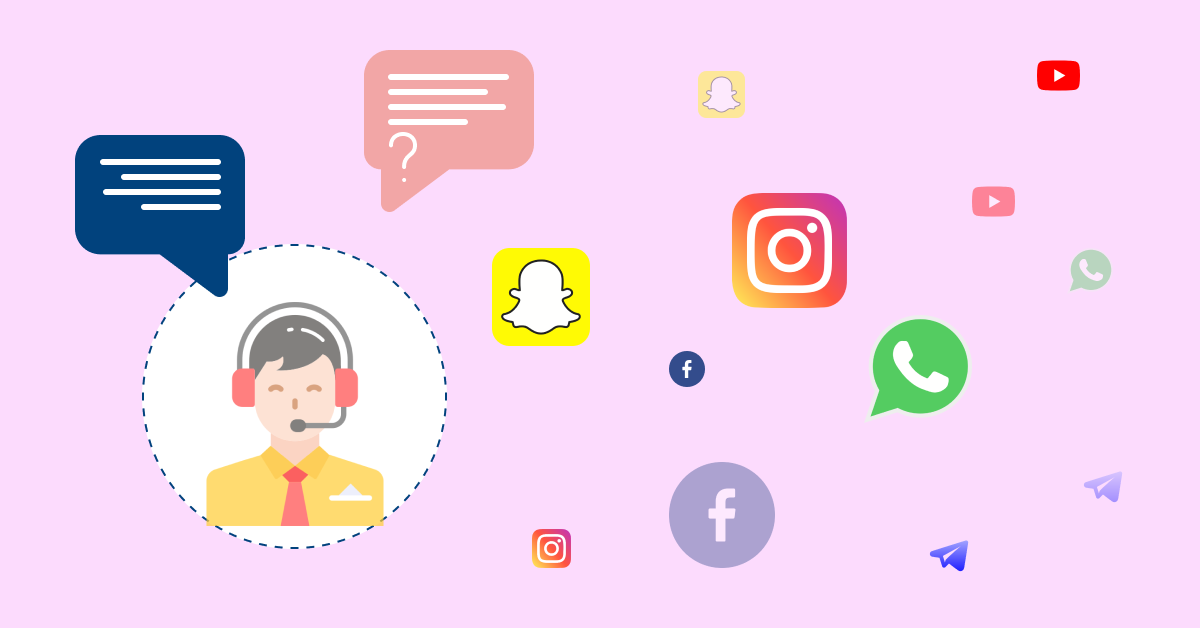
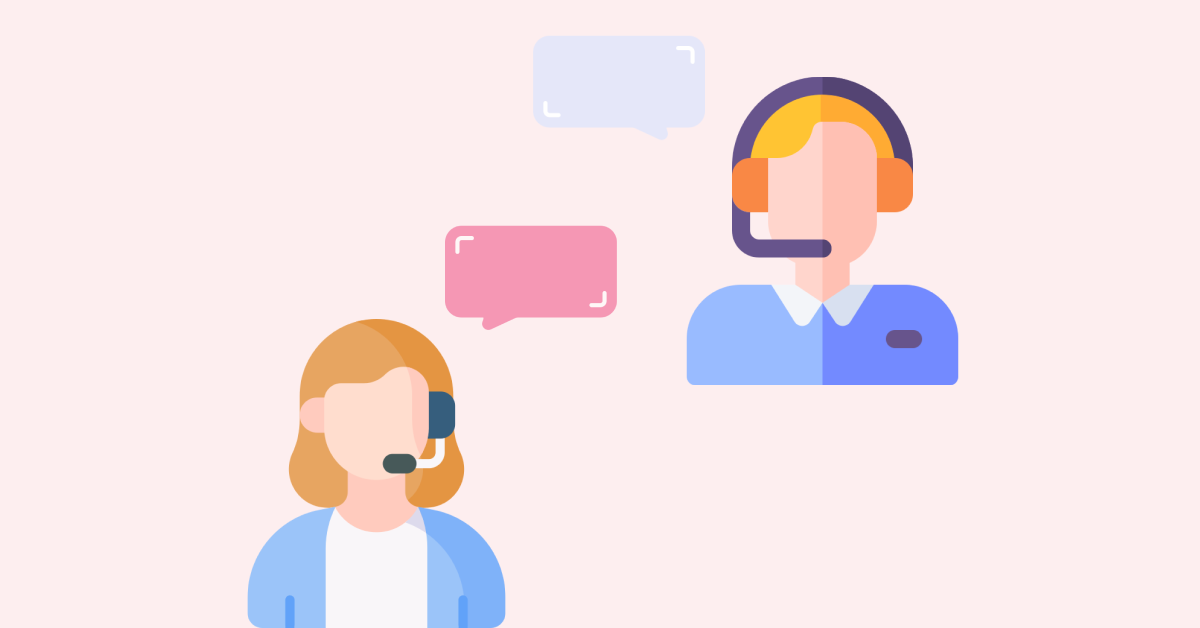 Chatbot Integration Process: Advantages, Use Cases & Examples
Scroll to top
Chatbot Integration Process: Advantages, Use Cases & Examples
Scroll to top